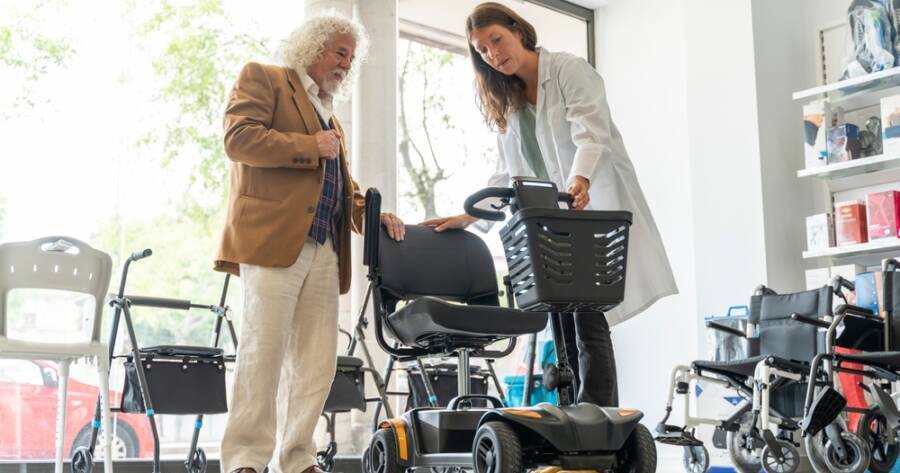If you or a loved one needs help moving around, Medicare is a valuable resource that should not be ignored. Medicare may cover the cost (or part of the cost) of a wheelchair or mobility scooter if certain requirements are met. Here’s what you need to know to qualify and get a Medicare scooter/chair for your independence and well-being.
Understanding Medicare Coverage for Mobility Equipment
Medicare offers coverage for various types of mobility devices, including wheelchairs and scooters. Medicare Part B, which covers medical equipment, can help you get a manual wheelchair, electric wheelchair, or mobility scooter if you meet specific eligibility requirements as explained at Medicare.gov.
To qualify for Medicare coverage, you’ll need to demonstrate that the equipment is necessary for your health. This means a doctor must determine that you need the device for daily tasks, like moving around your home safely. Medicare will only cover mobility equipment if it’s for use in the home. This is an essential requirement, as Medicare may not cover devices if they’re only for outdoor or recreational purposes.
Eligibility Requirements for a Medicare Wheelchair or Scooter
Medicare sets certain conditions to qualify for coverage of wheelchairs or scooters. First, a doctor must certify that you have a medical need for a mobility device. They’ll assess your physical limitations and confirm that a wheelchair or scooter is necessary for daily life. A simple cane or walker must also not be sufficient to meet your needs.
Additionally, you must be enrolled in Medicare Part B and pay the required deductible and coinsurance. Typically, Medicare will cover 80% of the cost for approved mobility equipment, leaving you to cover the remaining 20% unless you have additional insurance.
Lastly, it’s essential to get your equipment from a Medicare-approved supplier. Medicare requires beneficiaries to use providers within their network for coverage. Failing to do so may leave you responsible for the total cost of the device.
Steps to Get a Mobility Device Through Medicare
Getting a wheelchair or scooter with Medicare coverage involves a few steps. Following this process can make things smoother and ensure you qualify for benefits.
- See your doctor: Schedule a visit with your doctor, explaining your mobility challenges. They’ll evaluate your condition and may refer you to a specialist for further assessment.
- Receive medical documentation: After the evaluation, your doctor will issue a “Certificate of Medical Necessity” if they agree you need a mobility device.
- Choose a Medicare-approved supplier: Medicare requires you to select a supplier enrolled in their program. This ensures the device is covered under your Medicare benefits.
- Await approval: The supplier will submit paperwork to Medicare for approval. This process may take a few weeks.
Pick up your equipment: Once approved, you can pick up your wheelchair or scooter. Some suppliers even offer delivery to make the process easier.
It’s essential to follow these steps closely to avoid delays or issues with Medicare. Getting pre-authorization from Medicare before purchasing equipment can save you from unexpected costs.
Types of Medicare-Covered Mobility Devices
Medicare covers several types of mobility equipment, with varying options depending on your specific needs:
- Manual wheelchairs: Ideal for those with enough upper body strength to push themselves. These are lighter and may be more suitable for smaller homes.
- Power wheelchairs: Useful for individuals who cannot push themselves in a manual chair. Medicare requires an assessment from a doctor to ensure a power chair is medically necessary.
- Mobility scooters: Similar to power wheelchairs, scooters are often used by those who can stand but struggle with walking longer distances. They’re designed for use in larger spaces, so Medicare may only cover them if they’re practical for home use.
Each device has specific guidelines, and your doctor will determine which option best suits your needs based on their assessment.
Factors to Consider When Selecting a Medicare Mobility Device
Selecting the right mobility device is crucial. Here are some factors to consider:
- Home layout: If your home is small, a manual wheelchair may be more practical than a bulky power chair. Assess the doorways and maneuvering space to ensure the device fits comfortably.
- Mobility needs: Your physical abilities and lifestyle should guide your choice. If you need frequent, extended mobility, a scooter or power chair may offer the most support.
- Maintenance and cost: As mentioned, Medicare covers 80% of the cost, but you’ll need to handle maintenance and the remaining 20% if not covered by supplemental insurance. Make sure you can afford these expenses in advance.
Consulting with your doctor can help you choose a device that fits your needs and your home environment.
Explore Medicare Scooters/Chair Options Today
If you need a wheelchair or mobility scooter, Medicare can be an excellent option to help cover the costs. With the right documentation and guidance from your doctor, you can obtain a mobility device that improves your quality of life.
Be sure to follow Medicare’s guidelines and work with a Medicare-approved supplier to avoid any issues with coverage. Proper planning and preparation can help you get the mobility assistance you need with minimal stress.
